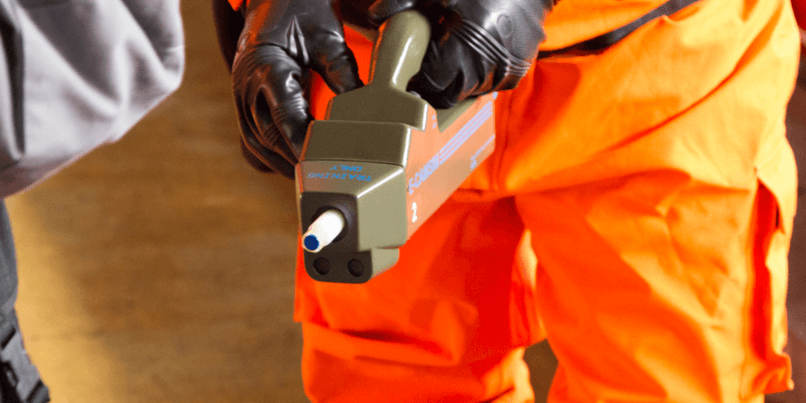
The successful management of a major hazardous materials or CBRNe incident hinges on personnel having access to the right equipment - and having the know-how, experience and confidence to handle that equipment effectively.
In this blog post, we summarize the features of four essential detection, identification and monitoring (DIM) tools, all of which are regularly used in the course of live CBRNe and HazMat response.
We also compare those products with examples of high-fidelity simulator equivalents that are widely used, with great effectiveness, in the carrying out of a diverse range of safety-critical training exercises.
1. Chemical Detection
Smiths Detection LCD3.3
The person-worn Smiths Detection LCD3.3 is acknowledged as one of the most widely deployed chemical detectors for the detection of Chemical Warfare Agents (CWAs.)
It detects a wide range of nerve, blood, blister and choking agents and can also be used for the identification of a selected library of Toxic Industrial Chemicals (TICs.)
The LCD3.3 also incorporates different operating modes to facilitate optimal detection capability. The device is simple to operate, it requires no calibration or routine maintenance and it can log up to 72 hours of mission data for further analysis. User-replaceable sieve packs also reduce the need for expensive and time-consuming factory-based overhauls.
A key benefit of this detector is its ability to specifically identify CWAs, however this highly advanced degree of selectivity can make simulant-based training much more of a challenge.
LCD3.3-SIM
The Argon LCD3.3-SIM is a simulator training device that has been designed to replicate all the features and functionality of the LCD3.3.
The simulation detector responds to electronic sources that imitate the effects of chemical vapors, toxic substances, false positives, fluctuations in wind direction and temperature and the depletion of sieve packs / batteries.
There is no requirement for simulants as part of training, which means there is no risk to personal safety or the environment. The device is also compatible with a wide variety of other simulator devices (including simulators for the AP2C, AP4C, CAM, LCD3.2 and the RAID-M100) to enable multi-detector and multi-substance training to take place within the same scenario.
2. Portable Chemical Contamination Control
Proengin AP4C
The Proengin AP4C is a portable chemical contamination control device used to directly detect a wide range of chemical agents (and their precursors) including: compounds of phosphorus (G and V agents), sulfur, arsenic compounds and gases such as ammonia, Cyanogen chloride and Cyahydric acid.
The four channels on the device can detect agents simultaneously, offering high sensitivity and fast response time in even extremely challenging environmental conditions.
AP4C-SIM
For training purposes, a simulator detector such as the Argon AP4C-SIM can provide an highly useful alternative to the actual AP4C. The simulator device can also be used in conjunction with other detection instruments that work on different technology principles - providing compatibility with CAMSIM, LCD3.2e-SIM, RAID-M100-SIM and the S4PE-SIM for multi-detector / multi-substance training exercises
3. Radiological Survey Training
Canberra / Mirion ADM 300A (V1B)
Canberra/Mirion ADM 300A (V1B) is an example of a multi-functional radiological survey meter. It is used for the detection, measurement and digital display of levels of gamma radiation dose rate from 0.01 μSv/h to 100 Sv/h and the accumulated dose of beta particles from 0.01 μSv/h to 100 Sv/h for gamma rays.
The ADM 300A is well known for being a portable, rugged and reliable instrument, suitable for use in in a wide range of challenging environments.
ADM 300A V1B-SIM
The ADM 300A V1B-SIM radiation training simulator, from Argon Electronics, provides an ideal substitute to the real device when conducting radiological survey training exercises.
First and foremost, it offers HazMat personnel and CBRNe response teams a means to safely and realistically train without relying on the use of any form of hazardous ionizing radiological source.
For the CBRNe instructor, it provides the ability to retain complete control of the exercise - and with the capacity to conduct examples of multi-detector or multi-threat training within the same operational scenario.
4. Electronic Personal Dosimetry
Thermo EPD Mk2
When attending CBRNe or HazMat incidents involving ionizing radiation, emergency services personnel need to be able to monitor their own exposure and to react quickly in the event that acceptable dose rate levels are exceeded. In such circumstances, they will rely on the use of an electronic personal dosimeter (EPD), such as the Thermo EPD Mk2. which has been designed to respond to gamma, beta and X-radiation. Radiation that is detected by the EPD is processed to provide an indication of penetrating dose, superficial dose and the dose rates.
EPD Mk2-SIM
A simulator EPD equivalent such as the EPD Mk2-SIM means instructors are able to retain all the user interface of the real dosimeter, but while removing the need for any form of ionising radiation source.The EPD Mk2-SIM device realistically simulates HP07 and HP10 dose, 1st and 2nd HP07 and HP10 alarms and chirp dose.
It is compatible with all Thermo EPD accessories (including the Teledosimetry system), and with Thermo administration and management software (including Easy EPD, Easy Issue, DCS and WebREMS), instructors can also transfer their operational batch file configuration to the simulator. The simple interface also enables health physicists to study and practice interpreting the downloaded dose history.
The deployment of simulator detectors for the purposes of HazMat and CBRNe training is widely regarded has been shown to deliver highly effective learning outcomes whilst ensuring the greatest levels of individual and environmental safety.
These high-fidelity tools provide the opportunity for trainees to immerse themselves in realistic scenarios that truly challenge them and that ensure the highest levels of training are achieved.






